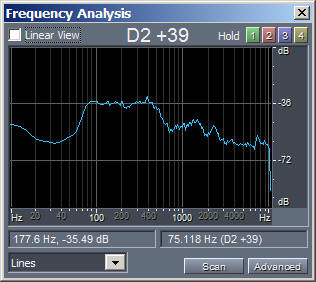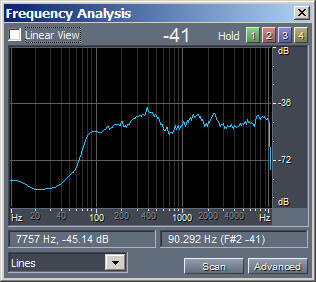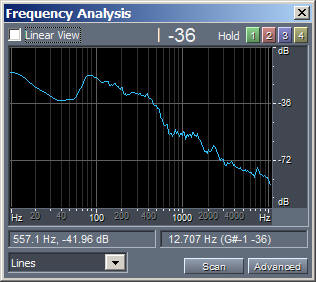Applied Acoustics course (6 CFU) - Progressive list of lessons |
|
This course is taught in EnglishThis course can be chosen by students of the following Post-Graduate (Advanced) Degrees: Communication Engineering, Electronics Engineering, Computer Engineering, Mechanical Engineering, Civil Engineering, Environment and Land Management Engineering, Physics, Architecture |
|
|
Attention: in academic year 2022/23 this course will be held IN PRESENCE. There will be no synchronous streaming of the lessons, for the reasons clearly explained in this article (in Italian). Please access the ancillary page containing the progressive list of lessons which also serves as a calendar of the lessons. Here you can download the didactical material, including the video recordings of the lessons which will be done in classroom. No other platform will be
employed (ELLY will NOT BE USED). |
|
Teaching Hours: Monday, 8.30 to 10.30 - Tuesday, 8.30-10.30 - Room 3 - first lesson is on 19 September 2022
Lecturer: prof. Angelo Farina
E-MAIL: farina@unipr.it
Website: http://pcfarina.eng.unipr.it/ or http://www.angelofarina.it/
Phone Number: 0521-905854 (not recommended)
Receiving hours: Tuesday, 10.30 to 12.30, in building #7 or, better, online using MS teams. This is the link to the "receiving hours" team; you can join this team without the need of asking permission to the teacher using this access code: jzdz20j
The access to receiving hours in presence (in building #7) is possible only after appointment arranged by E-mail, and with the same safety requirements explained above for attending the lessons in presence.
 COVID
Prevention
COVID
Prevention
BASED ON THE NEW PROVISIONS FOR THE PREVENTION OF THE SARS-Cov-2 CONTAGION issued with prot. n. 225 of 08/09/2022, and taking into account that the teacher is a "fragile subject", IT IS MANDATORY TO
- always wear FFP2 or FFP3 MASKS, correctly worn
- maintain an adequate social distance (sit one seat yes and one no, and a row yes and a no)
- periodically sanitize the hands by washing them with soap, or with the special gel available in the classroom
- in the case of a temporary need to remove the mask, students must first exit the classroom before doing so
- in case of fever or any other minor symptom, students must stay home and have a COVID test done ASAP. Even if the test is negative, do not return to the classroom until fully asymptomatic.
Students are requested to download, read and scrupulously respect the provisions of the aforementioned document, in order to minimize the risk of transmission of the virus among themselves and especially towards the teacher.
We strongly recommend the use of the FFP3 masks made by 3M mod Aura 9330+, the only ones that protect both the wearer (if correctly worn) and the other people present in the room. However, the use of correctly worn FFP2 masks is allowed (sealing the gaps on the sides of the nose by bending the metal headband appropriately); for this course it is not possible to use surgical masks or other non-FFP2 or FFP3 approved masks, or FFP2 masks which are not properly worn all the time.
During each interval the classroom will be ventilated by opening doors and windows to the outside, so, going into the winter, dress appropriately. It is also recommended that you get vaccinated again, as soon as updated vaccines are available.
If for any reason a student does not want or cannot adapt to the restrictive preventive measures referred to above, it is advisable that he does not show up in the classroom and makes use of the recordings of the lessons that will gradually be made available on this web page; he will also be able to make use of the two hours of reception per week, during which the possibility of remote connection via MS Teams is maintained, as clearly indicated here above.
In the unfortunate, but very probable, case that the COVID situation worsens again in the autumn, more restrictive measures may be adopted, including the "green pass" or the return to distance learning. Please consult this page to stay updated on the provisions in place.
Contents |
Introduction
The course of Applied Acoustics is an introductory course to a scientific and technological field undergoing a very rapid development, which offers great employment opportunities (even self-employment, this is one of the few fields where a single professional can still get enough money), and which involves disciplines apparently very different: architecture, structural engineering, physiology, psychology, statistics, physics, electronics, vibration mechanics, fluid dynamics, digital signal processing, telecommunications, measurements, hygiene of the workplace, music, musicology, virtual reality.
Obviously in a post-graduate course of 6 CFUs we can only provide a basic introduction to Applied Acoustics. A full acoustician is formed only through other additional advanced courses, such as courses for Competent Technicians in Environmental Acoustics (6 months, 30 CFUs) or Master Courses (1 year, 60 CFUs) available at some Italian universities, or even dedicated post-graduate degrees (2 years, 120 CFUs, for example the MSC program in Music and Acoustic Engineering of Politecnico di Milano).
Because of its multidisciplinary and transversal nature, the Course of Applied Acoustics is attended by students from various degree programs (almost all branches of Engineering, but also students of Architecture and Physics).
For students of all branches of engineering this is a mind-opening course, it is practically the only opportunity to see (or, rather, hear) the results of the techniques learned in previous courses, in which the purely theoretical foundations of modern advanced mathematical methods are taught. When the "numbers" are transformed in sound, abstruse and difficult mathematical procedures quickly become very clear and immediate, and the possibilities offered by sound editing systems on the PC, used extensively both during lectures and during laboratory exercises, make it possible to listen immediately (usually in real time) to the "effects" of filters or other devices (compressors, gates, convolvers, denoising, etc.).
Given the scientific interests of the teacher, the course covers both the noise-related topics common to all branches of engineering , and the more specific themes relative to the acoustics of theatres and cinemas, audio production in music and television / film, musical instruments, high fidelity recording and Stereo (1D), Surround (2D) and three-dimensional (3D, VR, AR) systems.
The topics are always presented with systematic help of test sounds, as this is the most direct way to make the various operations to be perceived.
|
EXAMPLE: Many students do not understand the physical meaning of "differentiation" and "integration" operators applied to a function. Math teachers tend to give "graphical" explanations , such as "the derivative is the slope of a curve" or "the integral is the area under a curve." These explanations are not useful for everyone... In acoustics, the operations of differentiation or integration modify the spectrum of a sound. In particular, differentiation boosts high frequencies (increases the sound level of 6dB/octave). On the contrary, integration boosts low frequencies. Here's an example, which allows to "listen" to differentiation and integration applied to a recording of the human voice: A more extended presentation of this topic is developed in this web page |
Program of the Applied Acoustics course
|
Didactical Approach
During academic year 2022/23 the lessons are currently planned to be in presence in the classroom. We will perform a new set of audio-video recordings of the lessons done in the classroom. These video recordings will be made available in the Progressive list of lessons, together with other supportive didactical material (old audio-video recordings of some years ago, lesson notes, data files, charts, audio files, etc.).
However, these video lessons are NOT a remote learning course. A proper remote learning course is made of short videos specifically tailored to remote learning and of interactive sessions employing a suitable videconferencing platform, such as Zoom (one of the few capable of high quality stereo audio, which is of utmost importance for this course). Here instead we provide just recordings of classroom lessons, which can be downloaded and watched offline.
An important part of the didactical activities are AUDIBLE EXPERIMENTS and usage of advanced electro-acoustic instrumentation, which are conducted in the classroom at every lesson, and which can only be experienced properly in physical presence in the classroom. Also the interaction with the teacher is fundamental, as at every lesson there is a "questions and answers" period. Furthermore, a number of in class-tests will be done.
In-class tests: a didactical tool, more than an evaluation tool. Some hints:
|
Method of Examination
The method of examination is in two parts:
1) mandatory intermediate written tests, usually in person in the classroom, or exceptionally online. The few students who cannot attend to in-class tests can be required to perform an alternative written test before the oral exam.
2) a simple oral exam, during which the student must answer to theoretical questions and solve some problems (including numerical calculations, so an hand-held calculator is required).
In both parts the student must be equipped with tables, charts, and any other support material required for solving numerical problems.
In case of public health problems related to COVID-19, both the intermediate tests and the final oral exam can be done online.
Electronic registration of exams
| Starting in
January 2015, the standard procedure for registering exams during the official
exam dates shown above is the electronic one, employing ESSE3 (https://unipr.esse3.cineca.it).
This means that every student must enlist for the exam on Esse3. And for doing that, the student must have got an approved study's plan, and must have completed the evaluation questionnaire for this course. Students who cannot enlist on Esse3 cannot make the exam: in no case the teacher will perform manual verbalization or wait to register the exam until a following exam session. Please contact the didactical secretary for problems with Esse3, and not the teacher, who has no control on that system. If, for any reason, the student cannot enlist on Esse3, there is no point contacting the teacher, as he cannot do anything for solving this problem. |
Recommended textbooks
The official textbooks for the Applied Acoustics course are:
- Patrizio Fausti: Acustica in Edilizia , Rockwool Italy, Milan (2005)
- Arianna Astolfi e Maria Giovannini: Acustica delle aule scolastiche, Rockwool Italy, Milan (2012)
These books are in Italian - free download in PDF format, you can also request for a free hardcopy to Rockwool. Thanks Rockwool!
The books RECOMMENDED (not mandatory) for thorough preparation of the exam are:
- R. Spagnolo (ed.): ACUSTICA, Fondamenti e applicazioni - Casa Editrice: UTET Universitą - Anno: 2015 - ISBN: 9788860084460
- Thomas D. Rossing (ed.): Springer Handbook of Acoustics , Springer Science + Business Media, New York (2014) - ISBN: 9781493907540
Additional
support material for the course (Excel spreadsheets, WAV files, etc..) used
during the lessons will be made available in the
"Public" section of this website:
http://pcfarina.eng.unipr.it/Public/Applied-Acoustics/2022/
- It is recommended to download especially the Excel
spreadsheets containing the exercises done in the classroom.
Audio / Video recording of the lessons
Starting from academic year 2010/2011, we are performing audio / video recording of the lessons, in AVI or MKV format, thanks to the Open Source program OBS Studio .
The following link points to a page containing a selection of these audio-video recordings, corresponding to the scheduled numbering of the lessons.
For each lesson the student can download:
- The Powerpoint file containing the slides employed
- The Note written by students of the academic year 2012/2013
- The Audio/Video recording of the old lesson
- The Audio/Video recording of the new lesson (as soon as it will be made available)
Prior of each lesson, the students should download and watch the previous' year audio/video recording, keeping an eye on the Note, so that they will get a background, albeit crude, of the topic which will be developed in class. After the lesson is done, the new recording will be made available, usually within a week.
Software
This is the list of software used during the lessons and lab sessions, with links to download them.
|
Name |
Description |
Link |
|
Adobe Audition |
Program for sound recording and playback, waveform editor, simple FFT analysis, sonogram, multitrack recorder, and it can act as a "host" program for plugins in three different formats (VST, Direct-X, XFM). The recommended versions are 1.5 (the best one) and 3.0 (if you need ASIO). An unrestricted version of Audition 3.0 can actually be downloaded for free from the Adobe web site linked here beside, after registering. Please DO NOT USE version 2.0 or version CS 5.5 and following (CC), as these are NOT compatible with Aurora plugins. And please, install the English version of Audition (and of any other program offering a multi-language interface!). Furthermore,
it is always mandatory to set the Regional Settings of your operating
system (in Control Panel) to English-UK or similar, NEVER in Italian!
This affects decimal separator, date, time and number formats... If
this setting is incorrect, operations such as Copy and Paste to another
program (i.e., Excel) are going to fail.... |
https://helpx.adobe.com/creative-suite/kb/cs2-product-downloads.html?promoid=19SCDRQK |
|
Aurora |
Suite of XFM plugins for Adobe Audition: generation of test signals (MLS, sweep) computation of the impulse response, acoustic parameters according to ISO 3382, calculation of inverse filters. Includes a fast convolution module, which is employed for performing auralization. See the warnings above for Audition regarding program version and regional settings. Aurora is shareware, with a "russian roulette" annoying-by-purpose feature. |
|
|
AudioMulch |
VST-Host general purpose program, programmable through the construction of block diagrams, coming with a wide range of effects. Easy to use. Versions for Windows and Mac. 90 days free trial. |
|
|
Plogue Bidule |
VST-Host general purpose program, programmable through the construction of block diagrams, coming with a wide range of effects. It is possible to create new effects. Shareware. Windows and Mac versions. It can also be used as a VST plugin inside another VST Host program. More tricky than Audio Mulch, but also more powerful. 90 days free trial. |
|
|
SynthEdit |
VST-Host program and compiler of VST plugins, programmable through the construction of block diagrams. Customizable interface with editable "skins". Contains an extensive library of graphical objects and of processing functions. Shareware. Better than Labview .... |
|
|
SpectraPLUS |
FFT and fractional-octave frequency analysis, cross-spectrum, sonogram, waterfall, signal generator for acoustic testing, measurement of reverberation times. Works with one or two channels, can be used to record and analyze WAV files. 30 days free trial. |
|
|
Ramsete |
Simulation of sound propagation in enclosed spaces and outdoors. Calculates the impulse response, and from it derives all the acoustical parameters. Includes a 3D CAD design module and a module for mapping results in colour or by isolevel curves. It also allows for the export of impulse responses in WAV format, for performing auralization. Free trial of the "Lite" version, the crack can be found on Emule, enabling full performance. |
|
|
DISIA |
The package includes Citymap and Disiapyr. These are programs for simulation of noise from road and rail traffic, which can operate both on a large scale (Citymap), and for detailed simulations (Disiapyr). They were developed as part of a DISIA project, funded by the Ministry of Environment, and are the reference computational models for the Italian fleet of vehicles. Free for academic usage (password required). |
Note: the above software is commercial software or shareware (excluding the last one, which is free, but the use is restricted to institutional goals of public administrations, and protected by password), although most of them provide a free running mode for a limited period of time, or indefinitely but with reduced functionality. Users who do not like this approach, can use the following open-source software:
|
Audacity |
Simple "open source" program for sound recording / playback, with many editing effects; it also operates in multitrack. Supports all platforms (Windows, Mac, Linux). A port of Aurora plugins for Audacity is under development (thesis available). A special version of Audacity containing some of the Aurora modules so far developed can be downloaded HERE. Please note that these Aurora modules DO NOT WORK on other versions of Audacity... |
http://audacity.sourceforge.net/
|
|
Sonicbirth |
Compiler for VST and AudioUnit plugis for Mac platform, with graphical interface of "block diagram" type. Interface customizable using editable "skins". It contains a wide library of graphic objects and processing functions. Similar to Synthedit, but less powerful and versatile. |
|
|
RoomEQ |
JAVA application for the measurement of the impulse response of a room with Exponential Sine Sweep and calculation of equalization filters for sound systems. It includes a realtime spectrum analyzer, a realtime Sound Level Meter, and a reverberation time measurement module. |
|
|
Psysound |
Matlab suite of modules, with user interface developed for processing of audio signals and acoustic analysis of all kinds |


